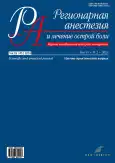Оптимизация методики ультразвуковой навигации блокады плечевого сплетения проксимальным подключичным доступом
- Авторы: Цветков В.Г.1, Лахин Р.Е.1, Полежанкин Е.В.1, Чарторижский Е.В.1, Цыганков К.А.1
-
Учреждения:
- Военно-медицинская академия им. С.М. Кирова
- Выпуск: Том 18, № 2 (2024)
- Страницы: 133-141
- Раздел: Оригинальные статьи
- URL: https://journals.rcsi.science/1993-6508/article/view/262171
- DOI: https://doi.org/10.17816/RA628810
- ID: 262171
Цитировать
Аннотация
Обоснование. При выполнении блокады плечевого сплетения в проксимальной подключичной области плоскость сканирования располагается глубже и кзади от средней точки ключицы. Имеются ограниченные данные, оценивающие угол наклона УЗ-датчика и визуализацию пучков плечевого сплетения.
Цель. Оценить визуализацию и позиционирование сосудисто-нервного пучка в подключичной области для проксимальной блокады плечевого сплетения.
Материалы и методы. Исследование было выполнено на пациентах-добровольцах (n=28, медиана — 43 года) клиники военной травматологии и ортопедии Военно-медицинской академии им. С.М. Кирова. Пациентам выполняли оценку сосудисто-нервного пучка с последующей блокадой плечевого сплетения.
Результаты. В процессе выполнения исследования отмечено, что наилучшая визуализация пучков плечевого сплетения отмечается при угле наклона датчика в среднем между 90° и максимальным значением, позволяющим визуализировать как минимум один из элементов плечевого сплетения, 64,4° (65,7°; 63°), что составило 77,5° (77,9°; 76,5°).
Заключение. Оптимальный угол выполнения блокады плечевого сплетения проксимальным подключичным доступом составляет 77,5°. Оптимальная визуализация плечевого сплетения возможна в диапазоне углов от 90 до 64,4°, что позволяет при выполнении блокады в данной области выбрать наиболее безопасную траекторию проведения иглы с учётом анатомических особенностей пациента. Необходимы дальнейшие исследования для сравнения используемых в реальной клинической практике углов наклона датчика с полученными в нашем исследовании углами.
Ключевые слова
Полный текст
Открыть статью на сайте журналаОб авторах
Василий Геннадьевич Цветков
Военно-медицинская академия им. С.М. Кирова
Автор, ответственный за переписку.
Email: vasilii_cvetkov@mail.ru
ORCID iD: 0000-0003-4980-597X
SPIN-код: 5316-4617
Россия, Санкт-Петербург
Роман Евгеньевич Лахин
Военно-медицинская академия им. С.М. Кирова
Email: doctor-lahin@yandex.ru
ORCID iD: 0000-0001-6819-9691
SPIN-код: 7261-9985
д-р мед. наук, доцент
Россия, Санкт-ПетербургЕвгений Владимирович Полежанкин
Военно-медицинская академия им. С.М. Кирова
Email: vasilii_cvetkov@mail.ru
ORCID iD: 0009-0007-6311-1698
Россия, Санкт-Петербург
Евгений Васильевич Чарторижский
Военно-медицинская академия им. С.М. Кирова
Email: chev89@mail.ru
ORCID iD: 0000-0002-9684-9783
SPIN-код: 8909-1230
Россия, Санкт-Петербург
Кирилл Алексеевич Цыганков
Военно-медицинская академия им. С.М. Кирова
Email: doctorcygankov@mail.ru
ORCID iD: 0000-0002-2357-0685
SPIN-код: 7133-0503
канд. мед. наук
Россия, Санкт-ПетербургСписок литературы
- Корячкин В.А., Заболотский Д.В. Место регионарных методов анестезии в хирургическом обезболивании // Медицина: теория и практика. 2018. Т. 3, № 4. С. 65–69. EDN: YZPBLV
- Овечкин А.М., Баялиева А.Ж., Ежевская А.А., и др. Послеоперационное обезболивание. Клинические рекомендации // Вестник интенсивной терапии имени А.И. Салтанова. 2019. № 4. С. 9–33. doi: 10.21320/1818-474X-2019-4-9-33
- Заболотский Д.В., Ульрих Г.Э., Малашенко Н.С., Кулев А.Г. Ультразвук в руках анестезиолога — эксклюзив или рутина? // Регионарная анестезия и лечение острой боли. 2012. Т. 6, № 1. С. 5–10. EDN: RPKKST
- Овечкин А.М., Политов М.Е., Морозов Д.В. Неврологические осложнения регионарной анестезии // Регионарная анестезия и лечение острой боли. 2018. Т. 12, № 1. С. 6–14. doi: 10.18821/1993-6508-2018-12-1-6-14
- Nadeau M.J., Lévesque S., Dion N. Ultrasound-guided regional anesthesia for upper limb surgery // Can J Anaesth. 2013. Vol. 60, N. 3. P. 304–320. doi: 10.1007/s12630-012-9874-6
- Корячкин В.А. Блокады периферических нервов и ультразвуковая навигация // Регионарная анестезия и лечение острой боли. 2020. Т. 14, № 1. С. 4–5. doi: 10.17816/1993-6508-2020-14-1-4-5
- Заболотский Д.В., Малашенко Н.С., Маньков А.В. Ультразвуковая навигация инвазивных манипуляций в анестезиологии // Сибирский медицинский журнал (Иркутск). 2012. Т. 113, № 6. С. 15–20. EDN: PFFBQH
- Лахин Р.Е., Корячкин В.А., Уваров Д.Н., и др. Интенсивная терапия при системной токсичности местными анестетиками (клинические рекомендации) // Тольяттинский медицинский консилиум. 2017. № 1. С. 28–36. EDN: ZNLYJH
- Aliste J., Bravo D., Layera S., et al. Randomized comparison between interscalene and costoclavicular blocks for arthroscopic shoulder surgery [published online ahead of print, 2019 Jan 11] // Reg Anesth Pain Med. 2019. rapm-2018-100055. doi: 10.1136/rapm-2018-100055
- Karmakar M.K., Sala-Blanch X., Songthamwat B., et al. Benefits of the costoclavicular space for ultrasound-guided infraclavicular brachial plexus block: description of a costoclavicular approach // Reg Anesth Pain Med. 2015. Vol. 40, N. 3. P. 287–288. doi: 10.1097/AAP.0000000000000232
- Demondion X., Herbinet P., Boutry N., et al. Sonographic mapping of the normal brachial plexus // AJNR Am J Neuroradiol. 2003. Vol. 24, N. 7. P. 1303–9.
- Sala-Blanch X., Reina M.A., Pangthipampai P., et al. Anatomic Basis for Brachial Plexus Block at the Costoclavicular Space: A Cadaver Anatomic Study // Reg Anesth Pain Med. 2016. Vol. 41, N. 3. P. 387–391. doi: 10.1097/AAP.0000000000000393
- Заболотский Д.В., Корячкин В.А. Ребёнок и регионарная анестезия — зачем? куда? и как? // Регионарная анестезия и лечение острой боли. 2016. Т. 10, № 4. С. 243–253. doi: 10.18821/1993-6508-2016-10-4-243-253
- Заболотский Д.В., Корячкин В.А., Ульрих Г.Э. Послеоперационная анальгезия у детей. Есть ли доступные методы сегодня? (современное состояние проблемы) // Регионарная анестезия и лечение острой боли. 2017. Т. 11, № 2. С. 64–72. doi: 10.18821/1993-6508-2017-11-2-64-72
Дополнительные файлы










